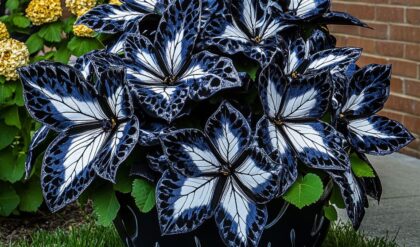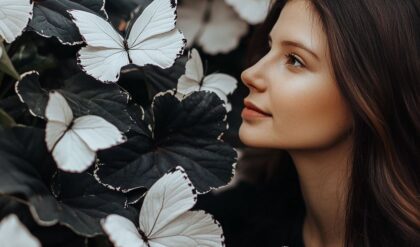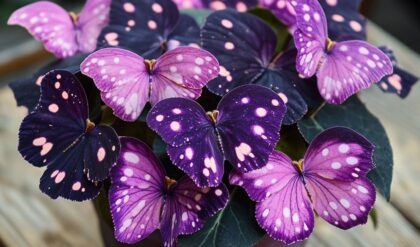Elephant ears, also known as Colocasia and Alocasia, are popular ornamental plants that are admired for their large, dramatic leaves. These plants are native to tropical regions and are popular among gardeners for their unique appearance and easy maintenance. In this article, we will explore the different types of elephant ears and provide tips on how to care for these plants.

Overview of Elephant Ears
Before we dive into the different types of elephant ears, let’s first understand what exactly these plants are. Elephant ears belong to the Araceae family and are known for their large, heart-shaped leaves that resemble the ears of an elephant. They are herbaceous perennials and can be either clumping or spreading in growth habit.
These plants are typically grown for their foliage, which comes in a variety of colors and patterns. The leaves can range from dark green to purple and may feature intricate veining or variegation. Some species also produce flowers, but they are not as showy as the leaves.
Elephant ears are relatively easy to grow and can thrive in a wide range of climates, making them a popular choice for both indoor and outdoor gardens. Now, let’s take a closer look at the different types of Colocasia and Alocasia.
Colocasia Varieties
Colocasia, also known as taro, is a genus of flowering plants that includes over 200 species. These plants are native to Southeast Asia and the Pacific Islands and are widely cultivated for their edible corms (a type of underground stem).

Diamond Head
The Diamond Head elephant ear is a popular variety known for its striking black leaves with green veins. This plant can grow up to 3 feet tall and is a clumping type, meaning it forms multiple stems from a single root system. The Diamond Head is also known for its fast growth rate and can reach its full size in just one season.
To grow Diamond Head elephant ears, choose a partially shaded location with well-draining soil. These plants prefer moist soil, but avoid overwatering as it can cause root rot. The Diamond Head variety is also suitable for growing indoors as long as it receives enough light. Consider using a humidifier or placing the plant on a tray of pebbles to increase the humidity levels.
White Lava
The White Lava elephant ear is another clumping variety that can reach heights of up to 4 feet. This plant has green leaves with white veins, giving it a unique marbled appearance. It is also a fast-growing variety, making it a popular choice among gardeners.
White Lava elephant ears prefer partial shade and well-draining soil. They require regular watering to keep their soil consistently moist. Avoid planting them in areas with strong winds as their delicate leaves can easily get damaged. As with most elephant ears, this variety can also be grown indoors with adequate light.

Illustrious
Illustrious elephant ears are a hybrid variety that combines the features of Colocasia and Alocasia. This plant has a black center with green veins, giving its leaves a dramatic contrast. It is a clumping variety that can reach heights of up to 3 feet.
To grow Illustrious elephant ears, choose a location with partial shade and well-draining soil. This plant is more sensitive to cold temperatures compared to other varieties, so make sure to protect it from frost during winter. You can also grow Illustrious elephant ears in containers and bring them indoors during the colder months.
Gigantia
As the name suggests, the Gigantia elephant ear is a giant variety that can reach heights of up to 5 feet tall. This plant has leaves that are green on top and deep purple underneath, giving it a stunning contrast. It is a clumping type and can add a tropical touch to any garden.
To grow Gigantia elephant ears, choose a location with partial shade and well-draining soil. This plant requires regular watering to keep its soil moist, especially during hot summer months. Consider using a slow-release fertilizer to give your Gigantia plant a nutrient boost.

Alocasia Varieties
Alocasia is a genus of flowering plants that belongs to the same family as Colocasia. These plants are native to Southeast Asia and feature large, showy leaves that come in many different colors and patterns.
Calidora
The Calidora elephant ear is an upright variety that can reach heights of up to 7 feet tall. This plant has large, deep green leaves with prominent veins that give it a tropical appearance. It is a clumping type and can quickly fill up any empty space in your garden.
To grow Calidora elephant ears, choose a location with partial shade and well-draining soil. This plant prefers consistently moist soil, but make sure to avoid overwatering. Consider using a slow-release fertilizer to provide essential nutrients to your plant.
Regal Shield
The Regal Shield elephant ear is a popular variety known for its large, glossy leaves. This plant has dark green leaves with silver veins, making it a striking addition to any garden. However, this variety is more sensitive to direct sunlight and can easily get sunburned.
To grow Regal Shield elephant ears, choose a location with partial shade and well-draining soil. This plant thrives in humid conditions, so consider using a humidifier to increase the humidity levels. You can also mist the leaves regularly to mimic its natural habitat.
Mayan Mask
The Mayan Mask elephant ear is a unique variety that features purple-backed leaves with curly veins. This plant can reach heights of up to 4 feet and has a clumping growth habit. It is a relatively low-maintenance variety, making it a great choice for beginner gardeners.
To grow Mayan Mask elephant ears, choose a location with partial shade and well-draining soil. This plant prefers consistently moist soil and high humidity levels, so make sure to water it regularly and provide adequate humidity. You can also add a layer of mulch around the base of the plant to help retain moisture in the soil.
Tips for Growing Elephant Ears
Now that we have explored the different types of elephant ears, here are some tips to help you grow these plants successfully:
Plant in a Suitable Space
When selecting a location to plant your elephant ear, consider its growth habit. Clumping varieties will quickly spread and take up more space, while spreading varieties will require more room to grow. Make sure to plant them in an area where they have enough space to reproduce without overcrowding other plants.
Consider Sun Tolerance
Elephant ears prefer partial shade, but some varieties can tolerate more sun than others. Before planting, research the sun tolerance of each type and choose the appropriate location. Some varieties, such as Regal Shield, are sensitive to direct sunlight and can get sunburned easily.
Indoor Growing
While most elephant ears are grown outdoors, some varieties can also be grown indoors. However, make sure to choose a spot with adequate light, as these plants thrive in bright, indirect light. Consider using grow lights if your indoor space lacks natural light.
Conclusion
In conclusion, elephant ears are a diverse group of plants with many different varieties to choose from. Whether you prefer the black leaves of Diamond Head or the large glossy leaves of Calidora, there is an elephant ear variety that will suit your preferences and growing conditions.
Remember to provide your elephant ears with the right amount of light, water, and nutrients to ensure their healthy growth. With proper care, these plants can add a touch of the tropics to your garden and make a stunning statement piece. So go ahead and experiment with different types of elephant ears, and don’t forget to share your progress with others!




